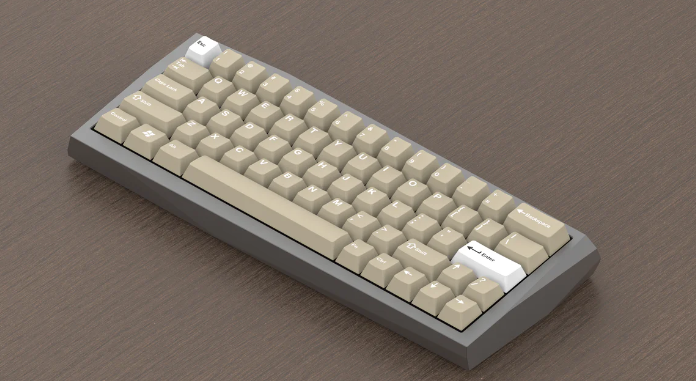An aluminum keyboard case is a housing or enclosure made from aluminum that is designed to protect and provide a stable base for a keyboard. Aluminum keyboard cases are commonly used for mechanical keyboards that are built from individual switches and circuit boards, as they offer protection and give the keyboard a uniform appearance that many users find aesthetically appealing. Aluminum keyboard cases are typically CNC-machined or formed from sheets of aluminum and can come in various shapes and sizes to accommodate different keyboard layouts and sizes. They may also be designed to incorporate additional features such as cable routing, adjustable feet, and bezels to cover the border of the keyboard.

What distinguishes the aluminum keyboard case from other keyboard cases?
Aluminum keyboard cases have several advantages over other types of keyboard cases:
1. Durability: Aluminum is a sturdy and durable material that can protect the keyboard from physical damage or impact.
2. Aesthetics: Aluminum has a sleek and modern look, which can give a premium feel to the keyboard.
3. Heat Dissipation: Aluminum is an excellent conductor of heat, which can help dissipate heat generated by the internal components of the keyboard.
4. Lightweight: Despite its strength, aluminum is relatively lightweight, making it easy to transport and move around.
5. Stability: Aluminum is a rigid material, which can provide a stable platform for the keyboard, reducing unwanted movement or flexing during use.
6. Maintenance: Aluminum is easy to clean and maintain, and is resistant to corrosion or rust.
Which aluminum type is best for making a keyboard case?
The best type of aluminum for making a keyboard case depends on a few factors, such as weight, durability, cost, and manufacturing considerations. Two of the most popular aluminum alloys used for keyboard cases are 6061 aluminum and 6063 aluminum.
-6061 aluminum is a high-strength alloy that offers excellent durability and resistance to corrosion. It is commonly used in aircraft, automotive, and marine applications, and is also popular in the keyboard community due to its strength, lightweight, and stiffness.
-6063 aluminum is a lower-strength alloy that is easier to extrude and shape, which can make it more affordable than 6061 aluminum. It also offers good corrosion resistance and can be anodized to produce a variety of colors.
Both alloys have their advantages and disadvantages, and the choice of which type of aluminum to use ultimately depends on the desired properties, budget, and manufacturing requirements. Regardless of the alloy used, a well-designed and well-constructed aluminum keyboard case can provide excellent protection, stability, and aesthetics for a mechanical keyboard.
What colors does the aluminum case have?
Aluminum keyboard cases can come in a variety of colors, depending on the manufacturer and product options. However, the most common color for an aluminum keyboard case is silver, which is the natural color of raw aluminum. Some manufacturers may offer additional color options, such as black, grey, blue, red, or gold, which is achieved by anodizing the aluminum or applying a colored coating. The availability of color options may also depend on the specific keyboard model or size, as some cases are designed to fit a specific keyboard layout.
How to make an aluminum keyboard case?
Making an aluminum keyboard case typically requires advanced tools, skills, and knowledge, as well as some specialized equipment and materials. Here are some general steps to help give an idea of the process, although this is not a comprehensive guide, and materials and processes may vary depending on the specific case design:
1. Design the case: The first step in making an aluminum keyboard case is to design the case using 3D modeling software or another design tool. This step involves considering factors such as the size of the keyboard, the placement of the keys, and any other features needed for the case, such as ports or cable routing.
2. Cut the aluminum sheet: Once the design is finalized, the aluminum sheet is cut into appropriate pieces using a CNC machine or manual saw.
3. Create openings and features: Additional openings or features such as screw holes, USB/USB-C/BLE port holes, and slots need to be machined into the aluminum sheets using a CNC machine or manual tools.
4. Bend and shape the pieces: The cut aluminum sheets are bent and shaped into the desired form using a bending brake or press. Different methods such as welding, bonding, or riveting may be used depending on the design.
5. Sand and finish the case: The aluminum pieces are then sanded, polished, and finished with a coating for extra durability and aesthetic appeal.
6. Assemble the case: The final step is to assemble the finished pieces into a complete keyboard case, attaching any hinge, pillars, or rubber feet as needed.
It’s important to note that making an aluminum keyboard case requires specialized skills and access to advanced tools and machinery. It’s not recommended for those who are inexperienced in metalworking or without access to proper equipment. Alternatively, there are many specialized manufacturers such as CNCJY that can produce custom aluminum keyboard cases based on customer designs and specifications.